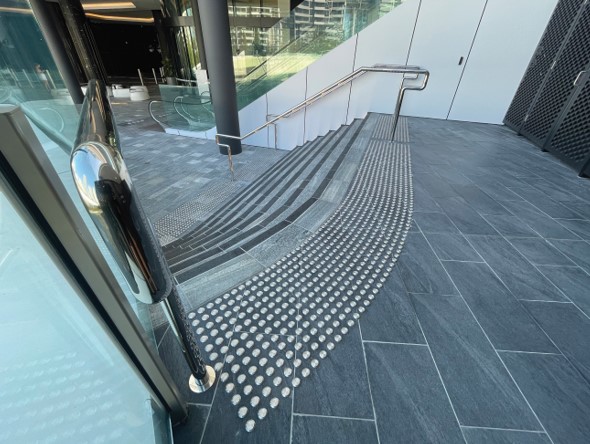An important consideration in building and construction is ensuring people of all abilities can safely access the built environment. Tactile Ground Surface Indicators (TGSI) are used widely on platforms, crossings, entries, ramps, escalators, and stairs. Tactile Systems Australia supplies a range of TGSI’s and other products to ensure all Australians can safety navigate the urban environment.
Vision 20/20 Australia reports that almost 600,000 Australians are either blind or living with some form of vision-impairment. These people are mostly over 65 years of age. These figures are expected to increase to 1.2 million by the year 2035. In addition, it is reported that 20% of Australians, or four million people will experience a permanent or temporary disability over their lifetime. The need for accessible built environments is vital to the health and well-being of all Australians.
Most people are aware of the part tactile indicators play in assisting vision impaired pedestrians to navigate the urban landscape safely. Not as well understood is the need for precision when it comes to location, colour, size and quality of tactiles. Tactile Systems Australia has the knowledge, skills and abilities built on decades of experience supplying TGSI’s and other safety and support products to the Australian building and construction industry.
Tactile Ground Indicator History
The first tactile ground surface indicator product is credited to Japanese engineer and inventor Seiichi Miyake. In 1965 Miyake developed tactile bricks to help a visually impaired friend. Two years later, Okayama City in western Japan became the first city to install tactile paving around the city. Ten years later the technology was widely adopted by the Japan National Railway, and by 1985, it became a requirement in cities around the country. Today, TGSI’s are everywhere in Australia, the U.K., the U.S., and many other countries around the world.
Tactile Systems Australia has a history going back to 1999 through a Sydney-based tactile systems franchise located in Helensvale, between Brisbane and the Gold Coast in Queensland. In 2006 it was still a small outlet, and around this time Tim Molloy joined the company, first working on the tools, then over the years as estimator, project manager, operations manager and as of April this year, general manager.
In 2016 as Tactile Systems Australia located in Ormeau, QLD; the company was sold to Philip Wedderburn who is now the sole proprietor. Nowadays, Tactile Systems Australia employs a dedicated team of individuals Tim says, “Is an outstanding group of people.” The range of quality products sourced from Australia and overseas has exploded to include tactile ground surface indicators, braille & tactile signage, bollards, corner guards, ceramic and polyurethane tiles, wheel stops, speedhumps, stair nosing, skate deterrents, Bike Racks, specialised adhesives, drill bits and templates, and line marking.
TGSI’s in the Community
The Disability Discrimination Act (DDA) of 1992 made it unlawful to discriminate against any person with a disability. The law set the stage for many effective Australian innovations including Tactile Ground Surface Indicators. TGSI’s assist persons with a full, or partial vision-impairment to navigate the built environment. They provide guidance, and in some cases also a warning of an obstruction or hazard in any location where insufficient natural tactile signals exist. TGSI’s assist blind or vision-impaired people with their orientation.
Tactile Ground Surface Indicators are, ‘Of or connected with the sense of touch, where vocal and visual signals become less important as tactile signals intensify.’ In a world where vision impaired pedestrians rely on consistency, complying with Australian Standards is an essential part of the product selection and installation process for architects and builders. Tactile Systems Australia products and services are carefully designed to comply with AS1428.4.1:2009. Their expertise and product knowledge enable Tactile Systems Australia to meet all customer and regulatory requirements.
Tim said, “We’ve been providing quality products and services to the building industry and public sector since 1999. Our products are carefully selected to meet Australian Standards and the National Construction Code, and standards for slip resistance and luminance contrast. We have extensive experience supplying an extensive number of projects over many years. Our projects include the Star Casino on the Gold Coast, MyState Bank Arena in Hobart, Karrawa Surf Club in Broadbeach; and 300 Queen Street in Brisbane, a soaring 24 level building that sets the benchmark for sophisticated, new ways of working.
Tactile Services
Tactile Systems Australia provides installation services using a fleet of skilled mobile installers. They also provide testing and consultancy services for builders and architects. They are one of the longest established tactile ground surface indicator and stair nosing specialists in Australia. With over 24 years’ experience in the industry, Tactile Systems Australia has a wealth of knowledge distributing and installing tactile ground surface indicators as well as stair nosing’s, and Braille and tactile signage to assist the disabled in public areas as well as providing safety for the visually impaired.
Tactile Systems Australia can provide their wide range of products from their two warehouses where extensive stock holdings can be dispatched anywhere in Australia. Purposely designed to maximise the lifestyle of its occupants and visitors, Tactile Systems Australia ensures secure and safe public access systems. Their functional products add value to architectural design, creating inclusive urban projects that improve the lives of all their occupants. Tactile Systems Australia; leading the way with a sense of touch.

